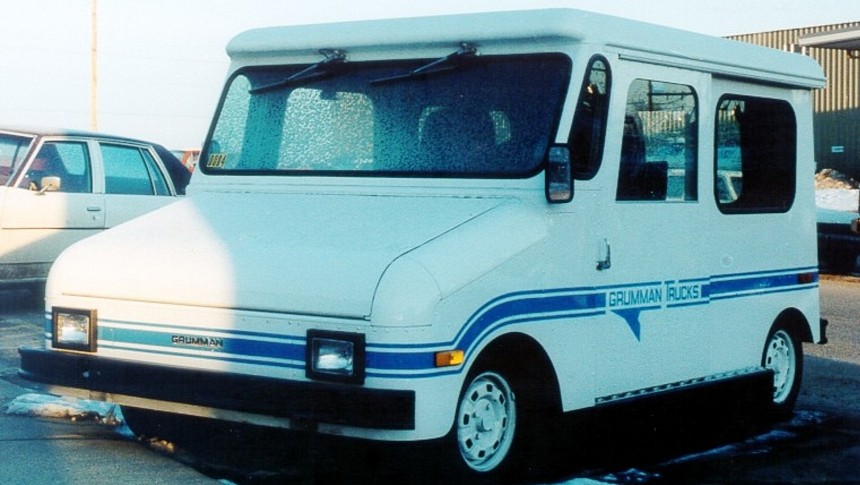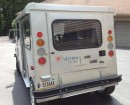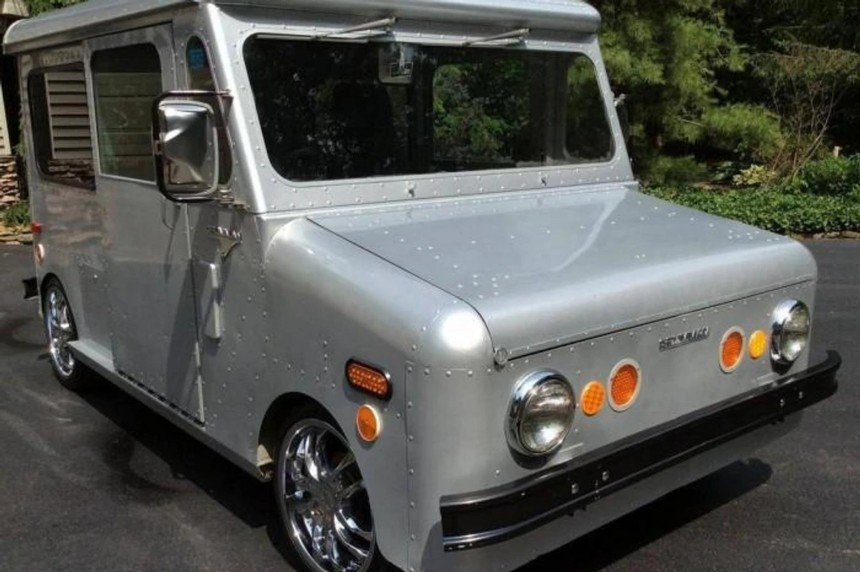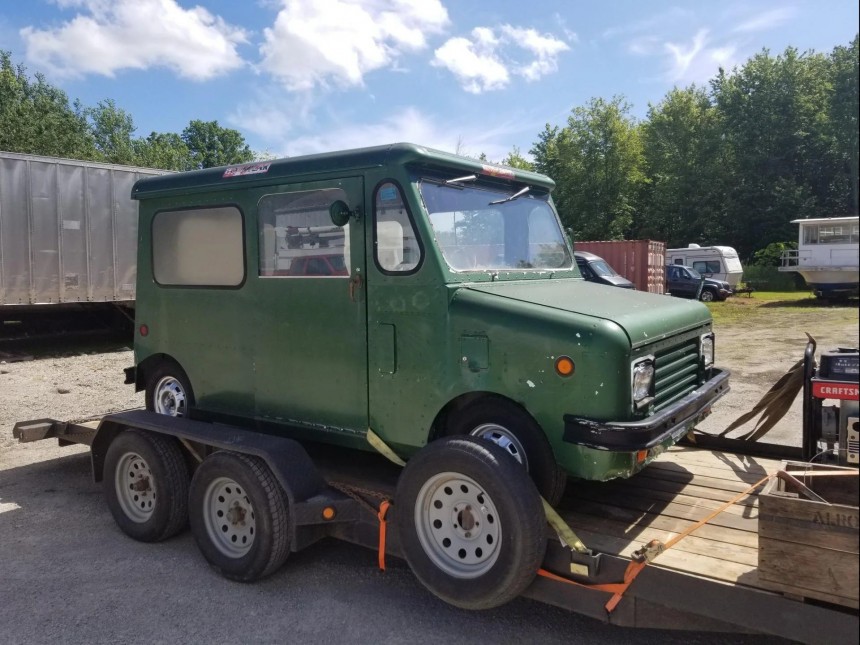Frigid in the wintertime, blistering in the summertime. Slow as molasses, with aerodynamics that makes a HUMVEE feel better about itself. A pain to drive on dry pavement and downright nightmarish in deep snow, even with chains. At the same time, the engine under the hood is about as powerful as an overly-ripe banana. Oh, and they're known to catch fire on occasion. These are just some of the criticisms one could levy at the Grumman Long Life Vehicle (LLV). But would turning North America's iconic mail truck all-electric fix any of these issues?
Judging from the fact that the United States Postal Service (USPS) fleet of Grumman LLVs is still powered by internal combustion; the answer to this would be no. But that didn't stop an iconic manufacturer of fighter jets turned mail-truck supplier at the Grumman Corporation from trying. This is the story of the Grumman KurbWatt, the USPS's iconic tinderbox of a mail truck gone all-electric. But first, a brief history behind the LLV and its military-aerospace-inclined manufacturer.
Most people who know about Grumman today know them as one-half of the modern Northrop Grumman military contractor. But back in the day, Grumman, based out of Bethpage on Long Island, New York, built some of the finest aircraft carrier-capable fighter planes for the U.S. Navy and the Marine Corps. Among their ranks included the F4F Wildcat and F6F Hellcat of Second World War fame, the F-11 Tiger Cold War Jet, and the iconic F-14 Tomcat twin-engine swing wing movie star of a fighter jet.
Though military contracts supplied most of the revenue generated by Grumman, the company didn't shy away from manufacturing other items in the civilian market. Among the products sold included multi-person canoes made from aircraft-grade aluminum, as well as box vans with bodies made from aluminum sheet metal. In a partnership between a New York City-based Chevrolet dealership named Walter Heingartner and the then commissioner of the New York State Liquor Authority, Jimmy Olson, devised the idea for a common truck chassis to carry a lightweight sheet-aluminum body and submitted the idea to one of Grumman's founders, a man called Jake Swirlbul, in 1939.
With a considerable intermission thanks to the Second World War, the newly-formed Grumman Olson Company began manufacturing aluminum-bodied delivery vans like the Kargo King, the Kurb Side, and the globally recognized Kurbmaster, famous for donning the logo of the American confectionary maker, Wonderbread. In 1963, the company moved its headquarters to the small town of Sturgis, Michigan, where it continues to operate today. From that point until the early 1980s, Grumman Olson operated strictly in the private sector, manufacturing their signature aluminum-bodied truck chassis for independent contractors and delivery companies across North America.
This nifty little commercial truck manufacturer did relatively well sales-wise during this period. But it's fairly difficult to sell gasoline/diesel transport trucks when the line for the fuel station stretches for four city blocks. But this was the conundrum that Grumman Olson, and indeed the entire global automotive sector, found itself in at the onset of the second global gas crisis of 1979. Spurred by oil-producing nations withholding fossil-fuel exports in response to the Iranian Revolution, Grumman Olson had a snowball's chance in hell of surviving as a company if the oil crisis hadn't faded away.
Without the benefit of hindsight, Grumman Olson decided the only solution was to offer a panel truck with an all-electric drivetrain. Dubbed the KurbWatt, Grumman Olson submitted their design proposal to the USPS in 1980, the same year the vehicle entered production. Indeed, it was the KurbWatt, not the LLV, which was the first corporate collaboration between Grumman Olson and the USPS, which only began production in 1987. Though smaller than the LLV, the similarity in appearance between it and the KurbWatt is still uncanny. It was hoped the use of an all-electric drivetrain could save up to 500,000 gallons of fuel per year compared to the outgoing rear-wheel-drive Jeep DJ.
With a curb weight of roughly 2,650 lbs (1,202 kg), only a handful of passenger cars manufactured today come anywhere close to being as lightweight as a Grumman KurbWatt. Had a sprightly engine been fitted under its hood, it might even be tempting to think this rear-wheel-drive mail truck is fun to drive. But a modern Lucid Air Sapphire powertrain, the Kurbawatt's six-volt, lead acid battery, and electric motor, was not. Reports from the few American towns that did receive KurbWatts for trial service found the KurbWatt could barely manage 55 mph (88.5 kph). A gasoline/diesel-powered variant called the KubVan was also manufactured at the same time as the KurbWatt.
Though information on the particulars of the KurbWatt's construction is hard to come by, its ICE-powered KubVan sister vehicle utilized a chassis based on the first-generation Volkswagen Caddy pickup truck. It's safe to assume the KurbWatt uses a similar basis for its construction. The first production order of ten Grumman KurbWatt light cargo trucks arrived at the USPS office in Evansville, Indiana, in 1981. Though the vehicle's paltry 40 miles (64.3 km) is laughable by modern standards, mail carriers found the little KurbWatt was more than suited for intra-city mail transportation while being more or less dead reliable. That's to be expected when the KurbWatt was designed to operate for at least 20 years.
A further 31 KurbWatts were delivered in an upgraded form to the city of Cupertino, California, in 1983, with a handful more being delivered to electric utility companies in Alameda, California, and Long Island, New York, the same year. As of 2012, a single KurbWatt is known to have been shipped to Bermuda; at that time, the vehicle was still in service. In short, the KurbWatt could have easily become the backbone of the North American postal transport fleet. But as the restrictions imposed by the second great global gas crisis faded with the start of the 1980s, the need for an all-electric mail vehicle went up in smoke.
Such an idea wasn't visited again until the KurbWatt's ICE-powered younger brother, the LLV, had already concluded most of its service life in the late 2010s. Meanwhile, Grumman Olson was acquired by the American JBPCO company in 2003 and promptly changed the company name to Morgan Olson the following year and continues to operate under that name to this day. All the while, the LLV mail truck still forms the bulk of the USPS mail carrier fleet.
In the end, only around 50 Grumman KurbWatts were ever manufactured, with 40 supplied to American post offices and a further ten given to private energy companies. The last USPS KurbWatts were withdrawn from active service in 1992, with a lack of an upgrade path as well as the raw expense of its electric motor and batteries cited as the primary impetus for its withdrawal from service. Today, a handful of KurbWatt chassis do show up on fringe auction websites as well as occasionally on eBay. It's fascinating to think what could have been had the KurbWatt managed to turn the USPS fleet fully electric.
Could the KurbWatt have spurred on the all-electric revolution decades ahead of time with the right support behind its back? The world will never know, but we do at least get a super cool and unique piece of American automotive history to talk about.
Most people who know about Grumman today know them as one-half of the modern Northrop Grumman military contractor. But back in the day, Grumman, based out of Bethpage on Long Island, New York, built some of the finest aircraft carrier-capable fighter planes for the U.S. Navy and the Marine Corps. Among their ranks included the F4F Wildcat and F6F Hellcat of Second World War fame, the F-11 Tiger Cold War Jet, and the iconic F-14 Tomcat twin-engine swing wing movie star of a fighter jet.
Though military contracts supplied most of the revenue generated by Grumman, the company didn't shy away from manufacturing other items in the civilian market. Among the products sold included multi-person canoes made from aircraft-grade aluminum, as well as box vans with bodies made from aluminum sheet metal. In a partnership between a New York City-based Chevrolet dealership named Walter Heingartner and the then commissioner of the New York State Liquor Authority, Jimmy Olson, devised the idea for a common truck chassis to carry a lightweight sheet-aluminum body and submitted the idea to one of Grumman's founders, a man called Jake Swirlbul, in 1939.
With a considerable intermission thanks to the Second World War, the newly-formed Grumman Olson Company began manufacturing aluminum-bodied delivery vans like the Kargo King, the Kurb Side, and the globally recognized Kurbmaster, famous for donning the logo of the American confectionary maker, Wonderbread. In 1963, the company moved its headquarters to the small town of Sturgis, Michigan, where it continues to operate today. From that point until the early 1980s, Grumman Olson operated strictly in the private sector, manufacturing their signature aluminum-bodied truck chassis for independent contractors and delivery companies across North America.
Without the benefit of hindsight, Grumman Olson decided the only solution was to offer a panel truck with an all-electric drivetrain. Dubbed the KurbWatt, Grumman Olson submitted their design proposal to the USPS in 1980, the same year the vehicle entered production. Indeed, it was the KurbWatt, not the LLV, which was the first corporate collaboration between Grumman Olson and the USPS, which only began production in 1987. Though smaller than the LLV, the similarity in appearance between it and the KurbWatt is still uncanny. It was hoped the use of an all-electric drivetrain could save up to 500,000 gallons of fuel per year compared to the outgoing rear-wheel-drive Jeep DJ.
With a curb weight of roughly 2,650 lbs (1,202 kg), only a handful of passenger cars manufactured today come anywhere close to being as lightweight as a Grumman KurbWatt. Had a sprightly engine been fitted under its hood, it might even be tempting to think this rear-wheel-drive mail truck is fun to drive. But a modern Lucid Air Sapphire powertrain, the Kurbawatt's six-volt, lead acid battery, and electric motor, was not. Reports from the few American towns that did receive KurbWatts for trial service found the KurbWatt could barely manage 55 mph (88.5 kph). A gasoline/diesel-powered variant called the KubVan was also manufactured at the same time as the KurbWatt.
Though information on the particulars of the KurbWatt's construction is hard to come by, its ICE-powered KubVan sister vehicle utilized a chassis based on the first-generation Volkswagen Caddy pickup truck. It's safe to assume the KurbWatt uses a similar basis for its construction. The first production order of ten Grumman KurbWatt light cargo trucks arrived at the USPS office in Evansville, Indiana, in 1981. Though the vehicle's paltry 40 miles (64.3 km) is laughable by modern standards, mail carriers found the little KurbWatt was more than suited for intra-city mail transportation while being more or less dead reliable. That's to be expected when the KurbWatt was designed to operate for at least 20 years.
Such an idea wasn't visited again until the KurbWatt's ICE-powered younger brother, the LLV, had already concluded most of its service life in the late 2010s. Meanwhile, Grumman Olson was acquired by the American JBPCO company in 2003 and promptly changed the company name to Morgan Olson the following year and continues to operate under that name to this day. All the while, the LLV mail truck still forms the bulk of the USPS mail carrier fleet.
In the end, only around 50 Grumman KurbWatts were ever manufactured, with 40 supplied to American post offices and a further ten given to private energy companies. The last USPS KurbWatts were withdrawn from active service in 1992, with a lack of an upgrade path as well as the raw expense of its electric motor and batteries cited as the primary impetus for its withdrawal from service. Today, a handful of KurbWatt chassis do show up on fringe auction websites as well as occasionally on eBay. It's fascinating to think what could have been had the KurbWatt managed to turn the USPS fleet fully electric.
Could the KurbWatt have spurred on the all-electric revolution decades ahead of time with the right support behind its back? The world will never know, but we do at least get a super cool and unique piece of American automotive history to talk about.











